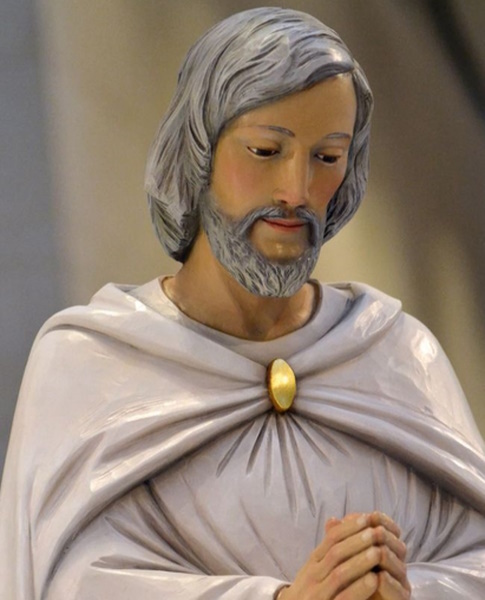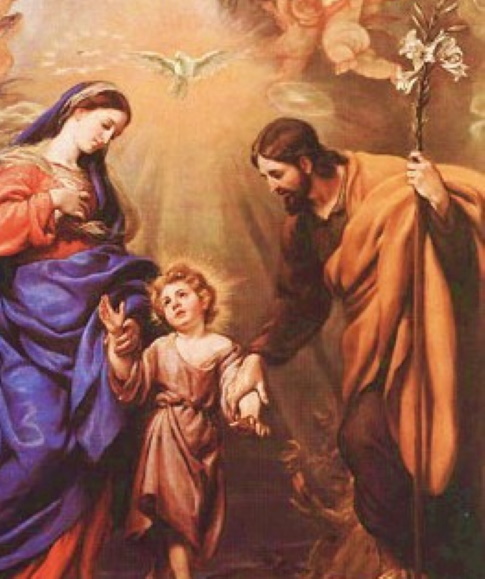19th March - St. Joseph's Day
Written by Anne Newman 2nd March 2020 updated 2023

March 19th is the principal feast day of Joseph the Husband of Mary in Western Christianity. At one time, Joseph was assumed to be elderly when he married Mary. However, now we believe that Mary and Joseph were both in their teens when Jesus was born, around sixteen and eighteen respectively. This was the norm for Jewish newlyweds at that time.
Joseph was a descendant of the house of David. When he married Mary, he found her already pregnant. However, when an angel came to Joseph in a dream and told him...
"Joseph son of David, do not be afraid to take Mary home as your wife, because what is conceived in her is from the Holy Spirit. She will give birth to a son, and you are to give him the name Jesus, because he will save his people from their sins,"
...he did as the angel told him and took Mary as his wife. (Matthew 1:19-25)
After Jesus’ birth at Bethlehem in Judaea, where the Holy Family received the Magi, an angel warned Joseph and Mary about the impending violence against the child by King Herod the Great of Judaea, whereupon they fled to Egypt. There the angel again appeared to Joseph, informing him of Herod’s death and instructing him to return to the Holy Land. Avoiding Bethlehem out of fear of Herod’s successor, Joseph, Mary, and Jesus settled in Nazareth (Matthew 2:22–23) in Galilee, where Joseph taught his craft of carpentry to Jesus.
Joseph is last mentioned in the Gospels when he and Mary frantically searched for the lost young Jesus in Jerusalem, where they found him in the Temple (Luke 2:41–49). Like Mary, Joseph failed to comprehend Jesus’ ironic question,
“ ‘Why were you searching for me? Did you not know that I must be in my Father’s house?’ ”
The circumstances of Joseph’s death are unknown, except that he probably died before Jesus’ public ministry began and was certainly dead before the Crucifixion (John 19:26–27).
Christian tradition represents Mary as a widow during the adult ministry of her son. Joseph is not mentioned as being present at the Wedding at Cana at the beginning of Jesus' mission, nor at the Passion at the end.
In the Gospels, Joseph's occupation is mentioned only once, not this the carpenter's son (ho tou tektōnos huios)? Matthew"tekton" (τέκτων) has been traditionally translated into English as "carpenter", but is a rather general word (from the same root that gives us "technical" and "technology" that could cover makers of objects in various materials.
The Greek term evokes an artisan with wood in general, or an artisan in iron or stone. Scholars have argued that tekton could equally mean a highly skilled craftsman in wood or the more prestigious metal, perhaps running a workshop with several employees.
Saint Joseph is regarded by Sicilians as their patron saint. They give thanks to Saint Joseph (San Giuseppe) for preventing a famine in Sicily during the Middle Ages. According to legend, there was a severe drought at the time, and the people prayed for their patron saint to bring them rain. They promised that if God answered their prayers through Joseph's intercession, they would prepare a large feast to honour him. The rains fell , and so the people of Sicily prepared a large banquet for their patron saint. The fava bean was the crop which saved the population from starvation and is a traditional part of Saint Joseph's Day altars and traditions. Giving food to the needy is a Saint Joseph's Day custom.
In some communities it is traditional to wear red clothing and eat a Neapolitan pastry known as a zeppola (created in 1840 by Don Pasquale Pinatauro in Napoli) on Saint Joseph's Day.

Maccu di San Giuseppe is a traditional Sicilian dish that consists of various ingredients and maccu that is prepared on this day. Maccu is a foodstuff and soup that dates to ancient times which is prepared with fava beans as a primary ingredient. On a typical Saint Joseph's Day altar, people place flowers, limes, candles, wine, fava beans, specially prepared cakes, breads, and cookies and zeppole. Foods are traditionally served containing bread crumbs to represent sawdust since Joseph was a carpenter. Because the feast occurs during Lent, traditionally no meat was allowed on the celebration table.
The altar usually has three tiers, to represent the Trinity of the Holy Family.

St Joseph appeared at Our Lady's side in the Apparition scene at Knock. He is always a quiet but strong presence, a father, a husband and protector. Devotion to St. Joseph has always emphasised his role as the protector of the Holy Family and he appears at Knock as a secure gentle presence beside his wife, head bowed reverently toward her acknowledging and reminding us of her unique place in the history of the Church. Knock Shrine
Pope Pius IX proclaimed St. Joseph the patron of the Universal Church in 1870. Having died in the "arms of Jesus and Mary" according to Catholic tradition, he is considered the model of the pious believer who receives grace at the moment of death, in other words, the patron of a happy death.
St. Joseph is the patron saint of a number of cities, regions and countries and many are named after him. According to the National Geospatial-Intelligence Agency, the Spanish form, San Jose, is the most common place name in the world.
St Joseph is also the patron saint of families, fathers, expectant mothers (pregnant women), explorers, pilgrims, travelers, immigrants, house sellers and buyers, craftsmen, engineers, and working people in general.
Some statues and pictures of Joseph depict his staff as topped with flowers, recalling the non-canonical account of how Mary's spouse was chosen by collecting the walking sticks of widowers in Palestine, and Joseph's alone burst into flower, thus identifying him as divinely chosen.





